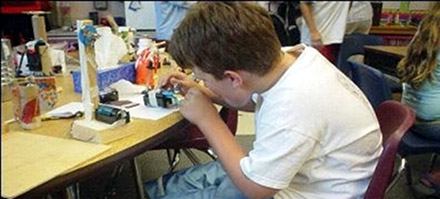
Wk 5: Expository Writing: Conclusion Paragraphs

Learning Outcomes:
- The learner will brainstorm what information would be most useful in a conclusion.
- The learner will use strategies to write a convincing conclusion.
Standards:
- Fourth Grade, English Language Arts, Goal 4, Objective 4.06
- Fourth Grade, English Language Arts, Goal 4, Objective 4.07
Assessment:
- The teacher should informally interview students to see which strategies the students chose to implement. If the teacher observes that students are not using the strategies relevant to this type of expository writing, then the teacher should work with the student to select and utilize and appropriate strategy.
Introduction:
“Invention Convention” is an integrated project combining learning from language arts, science, and math curriculums allowing students to apply their understandings of magnets and electricity by designing or improving an existing invention.
Classroom Time Required:
At least a one-hour time block for the whole group mini lessons is needed, and possibly more time for students to complete their independent writing.
Materials Need:
- Student Inventor’s Log
- Student “Focusing Plan”
- Student “Opening / Conclusion Plan”
- Copies of the “Expository Writing Peer / Teacher Rubric” found in the “Teacher Created Resources” column for week 6.
Pre-activities:
- Prior to this lesson, students should have completed “Focusing,” “Engaging Openings,” and “Developing Informative Paragraphs” lessons for the expository writing section of Invention Convention.
Activities:
- The teacher should begin this lesson by questioning / reviewing the purpose of expository information. The students should respond to share information. The teacher should further question what is the purpose of expository writing about inventions. The students should respond that this writing will help people to know more about their inventions.
- The teacher should then pair the students to work together for three to five minutes brainstorming the following question. “After reading your engaging opening, and your informative paragraphs, what would be important for a reader to read in a conclusion as the last information about a new invention?” After brainstorming and listing ideas in pairs, the students will share with the whole group. Some ideas may include:
-
- Show how the invention is useful for most people
- Describe an anecdote that would be possible for a person using the invention
- Show how the invention works better than other common types of the invention
- Explain why it would be “worth it” to buy or keep the invention
- Once the class has generated this list, or something similar, the teacher should challenge the students to plan and draft a convincing conclusion. The teacher should challenge the students to utilize at least two of the strategies that were brainstormed.
- The students should then use the “Opening / Conclusion plan” to plan their conclusions.
Modifications:
- Because the strategies listed utilize possible situations in the future, ELL students will have to learn the subjunctive test. One easy way to introduce this tense to students is through “If / then” sentences. “If / then sentences can be best used with “describing an anecdote that would be possible for a person using the invention.” For example, lets use the example of a student creating a “student desk lamp” to be used to see in dark spaces in desks at school. Working with the teacher, the teacher can help the student to write: If you can’t see, then you can turn on the light. Everyone uses a desk sometimes.” Or, “If you can’t find your pencil, then the lamp will give light. Everyone loses a pencil sometime.”
Supplemental Files:

